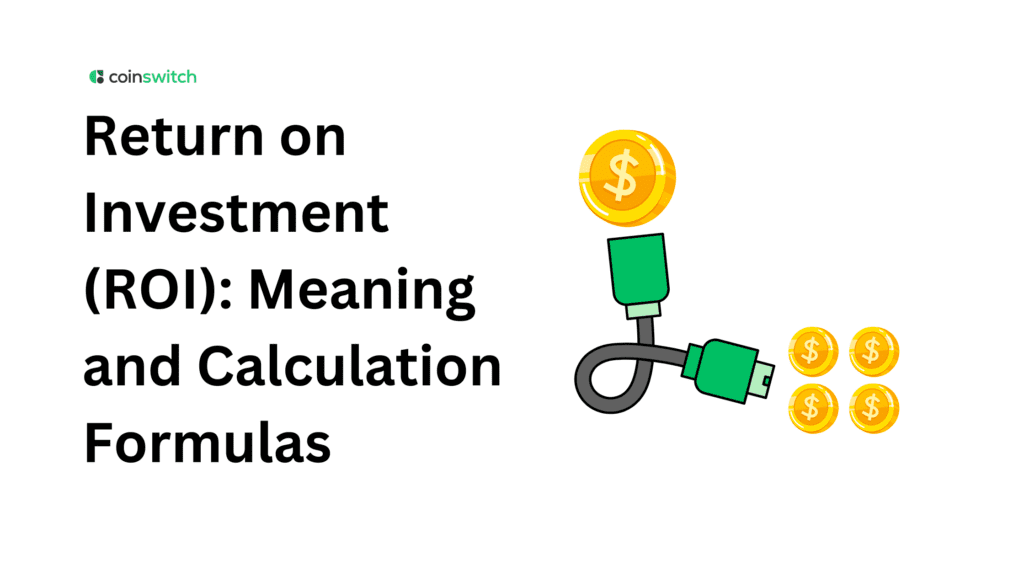Introduction of Return on Investment (ROI)
Money talks, but the real question is: how loudly? Every rupee, every dollar you spend or invest, whether into stocks, marketing campaigns, or even a side hustle, comes back to you with a story. Some stories are short and sweet (“I put ₹10,000, I got ₹12,000 back”). Others are complicated (“I spent two years running ads, hired a team, scaled a product… was it worth it?”). The shorthand answer to all these situations is one simple metric: ROI, Return on Investment.
ROI is one of those terms you hear everywhere, from finance classrooms to Silicon Valley pitch decks. It feels simple, but don’t mistake simple for shallow. ROI can be a quick back-of-the-napkin calculation, or it can be modeled with spreadsheets running hundreds of inputs.
This blog unpacks ROI in full, including its meaning, formulas, tweaks for different contexts, the benefits, drawbacks, and situations where ROI shines or falls short. Here, you’ll learn why ROI is still relevant as a metric, even when fancier acronyms like IRR, CAGR, or XIRR steal the spotlight.
What Is Return on Investment (ROI)?
Think of ROI as the financial equivalent of “Was it worth it?” You put in money, time, or resources. You get something back. ROI takes that story and squeezes it into one neat percentage.
In its rawest form, ROI compares your profit against what you originally invested. If you invested ₹1,00,000 and walked away with ₹1,20,000, ROI says: “Hey, that’s a 20% return.” It strips away drama and reduces everything to numbers.
But ROI isn’t locked inside finance textbooks. People use it casually everywhere. A student paying ₹20 lakh for an MBA will wonder: “What’s the ROI of this degree?” A startup founder will look at a ₹5 lakh Facebook ad campaign and ask: “Did the ROI justify the spend?” Even a family buying solar panels for their house thinks in ROI, “How many years until these panels pay for themselves?”
That’s the beauty of ROI. It’s universal, intuitive, and portable.
How to Calculate ROI
Here’s the classic ROI formula that every finance book loves:
ROI =Net ProfitInvestment Cost×100
Now, let’s break it down in plain language:
- Net Profit = what you made after subtracting costs.
- Investment Cost = what you originally invested.
- Multiply by 100 to convert it into a percentage.
Example: You invest ₹50,000 in mutual funds. A year later, it grows to ₹60,000. Net profit = ₹10,000.
Plug it in: (10,000 ÷ 50,000) × 100 = 20% ROI.
Easy, right? But here’s where real-life kicks in. Not all investments are clean like that. Companies might add taxes, interest, or hidden operational costs. Marketers sometimes count revenue instead of profit. Real estate investors often calculate ROI based on “cash in hand” instead of property value. The formula bends. That’s why whenever someone throws an ROI number at you, always ask: What’s included in those numbers?
Read More: Bullish vs. Bearish: Key Differences and Crypto Trading Impact
How to Understand ROI?
Numbers on their own don’t tell much. A 15% ROI might look amazing in one situation and unimpressive in another.
- In a bank FD (fixed deposit), 15% would be unheard of, so it’s fantastic.
- In equities, where long-term averages hover around 12–15%, that same 15% may look like “just okay.”
- For a venture capitalist betting on startups, 15% is almost meaningless; they want 5x or 10x returns, not 15%.
So ROI doesn’t live in a vacuum. It’s a conversation. You have to compare it with benchmarks, risk, and time. Otherwise, it’s like knowing the speed of your car without knowing if you’re on a highway or in a crowded Delhi lane.
ROI Example
Let’s play this out with a real-world scenario.
Suppose you buy a small shop in a busy market for ₹20 lakh. Over the year, you earn ₹2.4 lakh in rent, and then you sell the shop for ₹22 lakh.
- Net Profit = (Sale Price + Rent Earned) – Initial Cost
- Net Profit = (₹22,00,000 + ₹2,40,000) – ₹20,00,000 = ₹4,40,000
Now ROI = (₹4,40,000 ÷ ₹20,00,000) × 100 = 22% ROI
That number looks excellent. But if you dig in, did it take one year or five years? Because ROI doesn’t care about time. That’s both its strength (simplicity) and weakness (lack of context).
Read More: Scalping Strategies: Mastering Profit Making in the Market
Annualized ROI
This is where annualized ROI steps in. It fixes the “time blindness.”
Formula:
Annualized ROI = (Ending ValueBeginning Value)1n- 1
Where:
- Ending Value = Final investment value
- Beginning Value = Initial investment value
- n = Number of years
Take the shop example. If your 22% ROI happened over two years, the annualized ROI = about 10.4% per year. Suddenly, it looks less impressive when compared to stock market benchmarks.
That’s why professionals love annualized ROI. It levels the playing field across different time spans.
Alternative ROI Calculation
ROI is a chameleon; it changes colors depending on who’s using it.
- Marketing ROI: Spend ₹1 lakh on ads, generate ₹3 lakh in sales. ROI = 200%.
- Social ROI: NGOs measure returns in lives impacted, schools built, or trees planted, not rupees.
- Cash-on-Cash ROI: Real estate investors focus on the actual cash they invested versus cash earned, ignoring loans.
- Risk-Adjusted ROI: Asset managers don’t just want returns; they want returns per unit of risk.
So ROI isn’t one rigid formula. It’s a framework that adapts.
Investments and ROI
Every investment is essentially a gamble against ROI.
- Stocks: Did your portfolio beat the index? That’s ROI.
- Mutual Funds: Was your SIP worth it compared to FDs? ROI answers that.
- Startups: Angel investors live or die by ROI because nine out of 10 bets fail.
- Real Estate: Investors look at rental yield plus appreciation = ROI.
- Marketing Campaigns: Businesses justify ad budgets only if ROI looks positive.
Whether you’re an individual, a company, or a fund manager, ROI is the universal scorecard.
Leverage and ROI
Leverage is like adding steroids to ROI. It makes the results look bigger, both ways.
Example: You invest ₹1 lakh of your money and borrow ₹1 lakh more. Total = ₹2 lakh. The project earns ₹40,000.
- ROI without leverage = (40,000 ÷ 2,00,000) × 100 = 20%
- After interest (say ₹8,000), your net profit = ₹32,000
- ROI on your ₹1 lakh = 32%
That’s the magic of leverage; it boosts ROI. But the sword cuts both ways. If profits fall, ROI collapses. A small downturn can wipe you out. That’s why leverage gets respect and fear in equal measure.
Unequal Cash Flows
In real life, money doesn’t flow neatly. An SIP investor puts ₹5,000 every month. A business spends at irregular intervals. A property might earn rent every quarter.
Basic ROI fails here. That’s where XIRR (Extended Internal Rate of Return) comes in. It handles uneven cash flows, showing a more accurate “real ROI.”
So, while ROI is a great starting point, professionals move on to advanced metrics like CAGR and XIRR once the math becomes more complex.
Advantages of ROI
1. Simple to Use
ROI uses a basic formula; no need for complex spreadsheets or a solid finance background. Anyone can plug in numbers and make sense of the result.
2. Works Across Use Cases
From marketing to manufacturing, real estate to product launches, ROI fits almost every business scenario. It gives a financial view of outcomes regardless of the industry.
3. Universal Metric
Every team, sales, finance, and operations, can use ROI. It converts performance into a single, understandable number.
4. Helps Compare Investments
Whether you’re weighing a paid ad campaign against a product upgrade or choosing between two mutual funds, ROI brings everything to a common baseline for comparison.
5. Useful for Quick Checks
Need to justify an expense quickly? ROI offers a fast way to assess whether something delivered value or burned cash.
6. Supports Budgeting Decisions
ROI helps teams prioritize where to allocate time, money, and talent. Higher-return projects often move up the queue.
7. Scales With Business Size
ROI works for startups, SMBs, and large enterprises alike. It adapts whether the investment is ₹1,000 or ₹10 crore.
8. Encourages Outcome-Driven Thinking
Focusing on ROI keeps efforts outcome-oriented. It encourages decision-makers to think about results rather than activity.
Disadvantages of ROI
1. Ignores Time Frame
ROI doesn’t show how long the return took. A 50% return over 1 year is significantly different from a 50% return over 5 years.
2. Doesn’t Account for Risk
ROI doesn’t show volatility or predictability. A high-return investment might carry high risk, but ROI won’t reflect that.
3. Easy to Manipulate
ROI depends on which costs and benefits are included. Tweaking inputs can inflate or deflate the final number.
4. Misses Non-Financial Benefits
Improvements in customer experience, brand equity, or employee morale don’t show up in ROI. This limits its value in softer areas.
5. May Oversimplify Complex Projects
Multi-stage investments with indirect or delayed benefits often don’t fit neatly into the ROI formula, leading to partial or misleading insights.
6. No Industry Benchmark
A “good” ROI depends on context. Without a benchmark or peer comparison, a single figure may lack meaning.
The Bottom Line
ROI is like a compass; it points you in a direction but doesn’t show the whole map. Use it to ask: Is this investment worth it at first glance? But don’t stop there. Layer it with time (annualized ROI), risk (Sharpe ratio, volatility), and context (benchmarks).
That’s why ROI hasn’t disappeared even with fancier metrics around. It’s easy, universal, and sticky. But the smartest investors know: ROI is the headline, not the whole article.
FAQs
1. What Is ROI?
ROI (Return on Investment) measures how much profit an investment generates compared to its cost. It’s a simple formula:
ROI = (Net Profit / Investment Cost) × 100
This percentage helps investors and businesses judge how efficiently money was used. ROI works across use cases, from stocks and real estate to marketing and operations.
2. How Is Return on Investment (ROI) Used?
ROI is used to compare results, allocate budgets, and justify spending. Marketers track ROI to optimize campaigns. Business leaders use it to choose between competing projects. Investors rely on it to assess returns across stocks, real estate, and other assets. It simplifies decisions by reducing everything to one comparable number.








